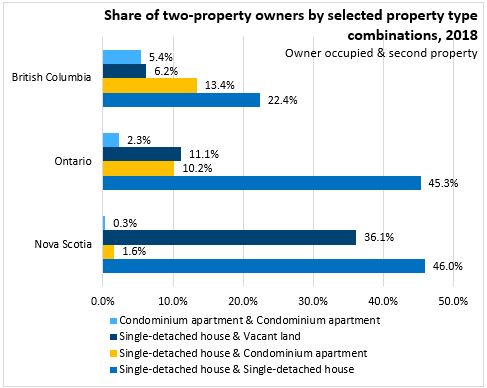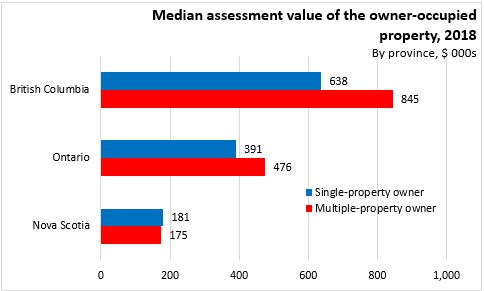The Economics and Statistics Division maintains archives of previous publications for accountability purposes, but makes no updates to keep these documents current with the latest data revisions from Statistics Canada. As a result, information in older documents may not be accurate. Please exercise caution when referring to older documents. For the latest information and historical data, please contact the individual listed to the right.
<--- Return to Archive
For additional information relating to this article, please contact:
September 27, 2019CANADIAN HOUSING STATISTICS PROGRAM: REAL ESTATE HOLDINGS BY MULTIPLE-PROPERTY OWNERS, 2018 Statistics Canada has released new information from the Canadian Housing Statistics Program, which provides information on residential property ownership in Canada. This article aims to understand the characteristics of multiple-property owners in British Columbia, Ontario and Nova Scotia. In this analysis, properties that were not owner-occupied but were used to generate income or capital gains (including renting or re-selling), or for personal use on an occasional basis (including cottages) were included. People who own multiple residential properties are people whose name is on the property title of more than one residential property within a given province. People who owned one property in a given province and a second property in another province were excluded as were residential properties owned by firms and governments.
In Nova Scotia in 2018, there were 82,660 multiple-property owners. Most of the multiple-property owners were outside of Halifax (64.8 per cent), as were single-property owners. Most multiple-property owners in Ontario and British Columbia lived in Toronto (43.0 per cent) or other CMAs (34.5 per cent) and Vancouver (53.6 per cent).
Multiple-property owners tended to be closer in age to single-property owners in Ontario and British Columbia, while the gap was slightly larger in Nova Scotia. In Nova Scotia, the median age of multiple-property owners was 59 compared to 55 for single-property owners.
Multiple-property owners in the three provinces were most likely to own only two properties. In Nova Scotia, 70.2 per cent of multiple-property owners owned two properties, compared to 76.7 per cent in British Columbia and 76.0 per cent in Ontario. The most common combination of property types for two-property owners was two single-detached houses. This share was higher in Nova Scotia and Ontario compared to British Columbia, where there is a higher prevalence of condominium ownership among multiple-property owners. Multiple-property owners in Nova Scotia were more likely to own a single-detached house and vacant land (36.1 per cent) compared to owners in Ontario and British Columbia.

Most multiple-property owners tended to reside in single-detached houses. In Nova Scotia, 91.4 per cent of multiple-property owners occupied a single-detached house, along with 82.6 per cent in Ontario and 58.1 per cent in British Columbia. Multiple-property owners’ usual residence varied across CMAs in these provinces, with those in Vancouver and Victoria least likely to reside in single-detached houses and more likely to reside in condominiums or properties with multiple residential units compared to owners in other CMAs.
Most owners live in the same census subdivision (geographic areas typically smaller than CMAs). This could indicate that owners are more likely to rent their other properties, assuming they would be more likely to have recreational properties outside the area where they live.
Multiple-property owners occupied properties typically had higher assessed values than those occupied by single-property owners. However, in Nova Scotia, the median assessed value of the owner’s usual residence was lower than for single-property owners. In the major CMAs, including Halifax, the median assessment value of owner-occupied dwellings increased with the number of properties owned.

Full report | Daily Release
Table 46-10-0038-01 Single- and multiple-property owners: demographic data, number and value of properties owned
Table 46-10-0041-01 Owners of two properties: types of properties owned
<--- Return to Archive